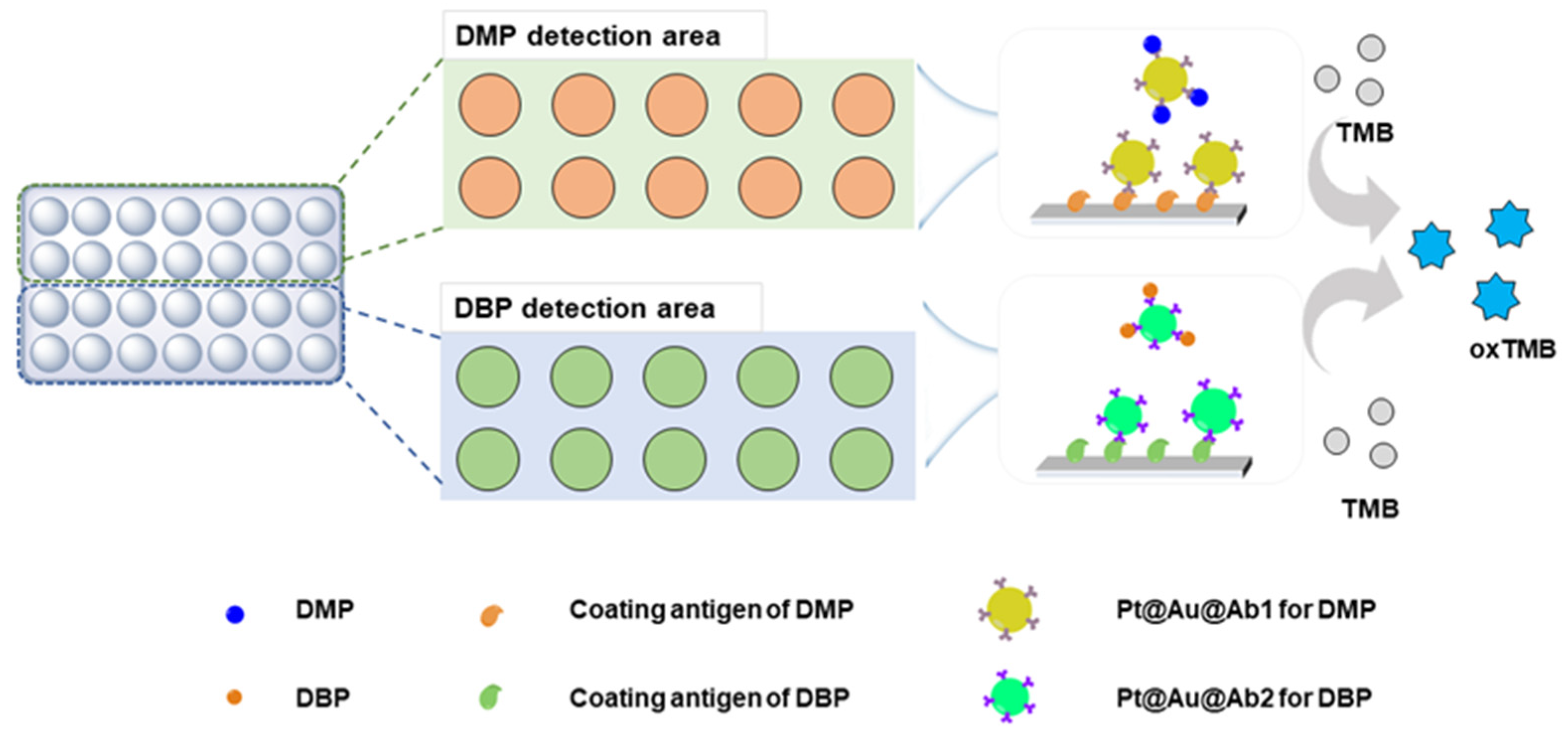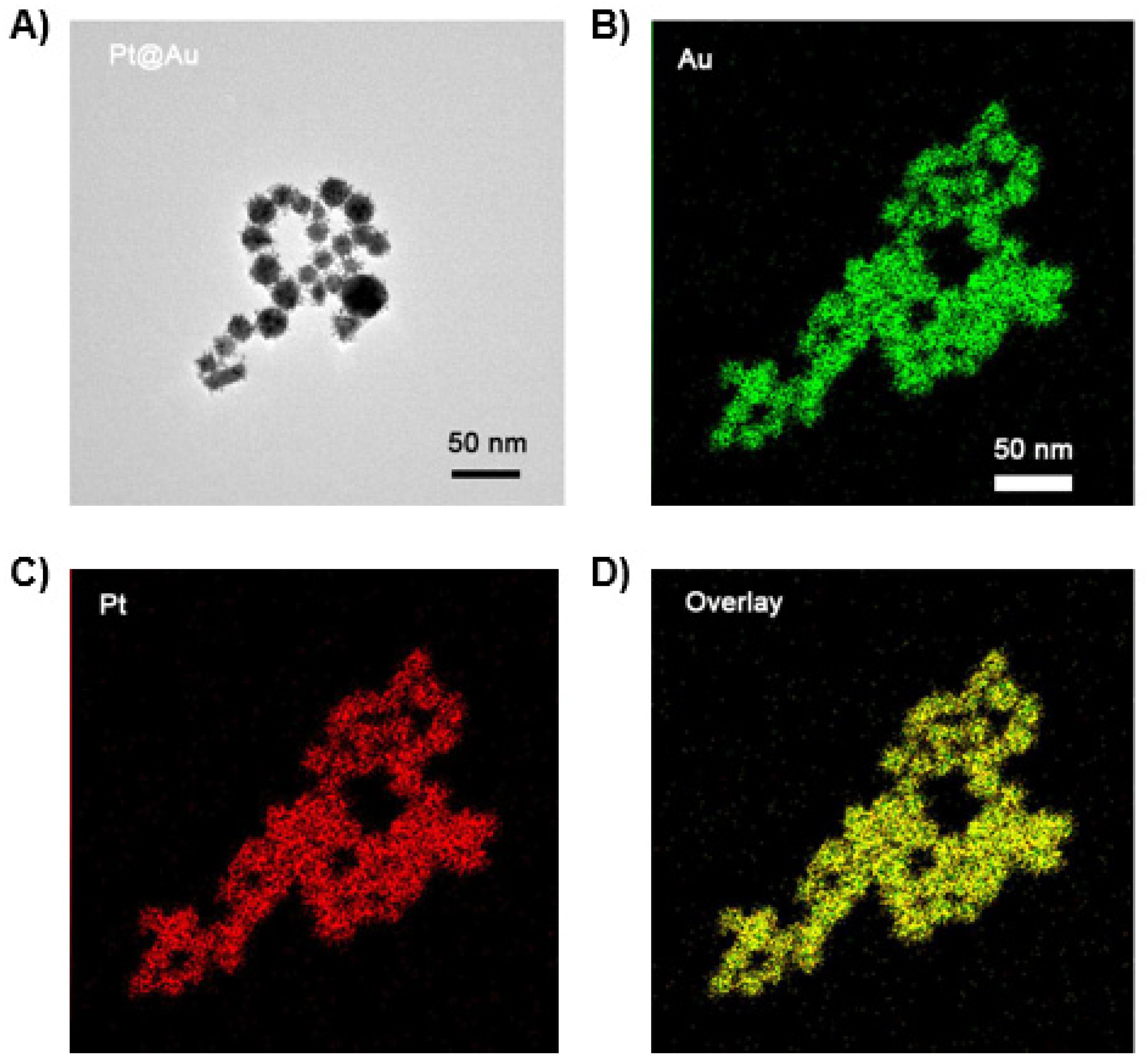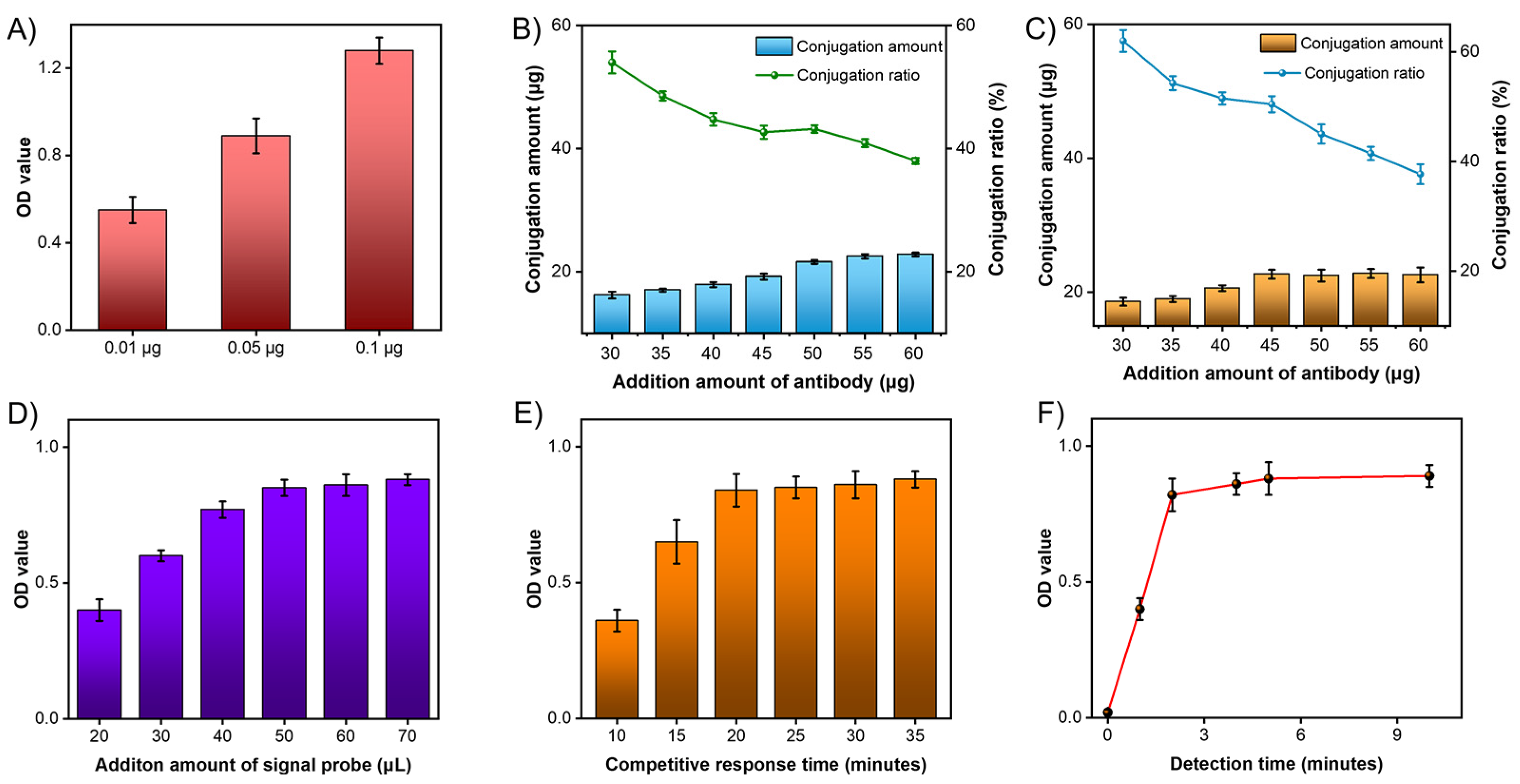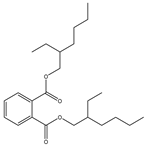A Nanozymatic-Mediated Smartphone Colorimetric Sensing Platform for the Detection of Dimethyl Phthalate (DMP) and Dibutyl Phthalate (DBP)
Abstract
:1. Introduction
2. Materials and Methods
2.1. Reagents and Instruments
2.2. Preparation of Coating Antigen
2.3. Preparation of Signal Probes and Coated Microporous Plate
2.4. Test Process
2.5. Samples Pretreatment and HPLC Verification
3. Results
3.1. Detection Principle of the Developed Colorimetric Immunoassay
3.2. Characterization of Pt@Au
3.3. Optimization of Detection Conditions
3.4. Development of Standard Curve for DMP and DBP
3.5. Specific Evaluation of the Constructed Colorimetric Immunoassay
3.6. Analytical Application in Real Samples
4. Discussion
Supplementary Materials
Author Contributions
Funding
Institutional Review Board Statement
Informed Consent Statement
Data Availability Statement
Conflicts of Interest
References
- Zereyesus, Y.A.; Cardell, L.; Valdes, C.; Ajewole, K.; Zeng, W.; Beckman, J.; Ivanic, M.; Hashad, R.N.; Jelliffe, J.; Kee, J. International Food Security Assessment, 2022–32. 2022. Available online: https://www.ers.usda.gov/publications/pub-details/?pubid=104707 (accessed on 9 September 2022).
- Lian, T.; Haq, S.U.; Shahbaz, P.; Zhao, L.; Nadeem, M.; Aziz, B. Changing Food Patterns during the Pandemic: Exploring the Role of Household Dynamics and Income Stabilization Strategies. Sustainability 2022, 15, 123. [Google Scholar]
- Ncube, L.K.; Ude, A.U.; Ogunmuyiwa, E.N.; Zulkifli, R.; Beas, I.N. Environmental impact of food packaging materials: A review of contemporary development from conventional plastics to polylactic acid based materials. Materials 2020, 13, 4994. [Google Scholar] [PubMed]
- Lu, Y.; Tang, F.; Wang, Y.; Zhao, J.; Zeng, X.; Luo, Q.; Wang, L. Biodegradation of dimethyl phthalate, diethyl phthalate and di-n-butyl phthalate by Rhodococcus sp. L4 isolated from activated sludge. J. Hazard. Mater. 2009, 168, 938–943. [Google Scholar] [PubMed]
- Xu, L.J.; Chu, W.; Graham, N. A systematic study of the degradation of dimethyl phthalate using a high-frequency ultrasonic process. Ultrason. Sonochem. 2013, 20, 892–899. [Google Scholar] [CrossRef] [PubMed]
- Ulucan-Altuntas, K.; Saleem, M.; Tomei, G.; Marotta, E.; Paradisi, C. Atmospheric plasma-based approaches for the degradation of dimethyl phthalate (DMP) in water. J. Environ. Manag. 2022, 301, 113885. [Google Scholar]
- Moeini, A.; Germann, N.; Malinconico, M.; Santagata, G. Formulation of secondary compounds as additives of biopolymer-based food packaging: A review. Trends Food Sci. Technol. 2021, 114, 342–354. [Google Scholar]
- Rahman, M.; Brazel, C.S. The plasticizer market: An assessment of traditional plasticizers and research trends to meet new challenges. Prog. Polym. Sci. 2004, 29, 1223–1248. [Google Scholar] [CrossRef]
- Horn, O.; Nalli, S.; Cooper, D.; Nicell, J. Plasticizer metabolites in the environment. Water Res. 2004, 38, 3693–3698. [Google Scholar] [CrossRef]
- Wadey, B.L. An innovative plasticizer for sensitive applications. J. Vinyl Addit. Technol. 2003, 9, 172–176. [Google Scholar] [CrossRef]
- Bolat, G.; Yaman, Y.T.; Abaci, S. Molecularly imprinted electrochemical impedance sensor for sensitive dibutyl phthalate (DBP) determination. Sens. Actuators B Chem. 2019, 299, 127000. [Google Scholar]
- Fankhauser-Noti, A.; Grob, K. Blank problems in trace analysis of diethylhexyl and dibutyl phthalate: Investigation of the sources, tips and tricks. Anal. Chim. Acta 2007, 582, 353–360. [Google Scholar] [CrossRef]
- Yu, L.; Shen, Y.; Gao, P.; Zhang, Q.; Hu, X.; Xu, Q. A novel molecularly imprinted photoelectrochemical aptasensor based on dual recognition mechanism for ultratrace detection of plasticizer dibutyl phthalate. Chem. Eng. J. 2023, 472, 144925. [Google Scholar]
- Peng, B.; Li, G.; Li, D.; Dodson, S.; Zhang, Q.; Zhang, J.; Lee, Y.H.; Demir, H.V.; Ling, X.Y.; Xiong, Q. Vertically aligned gold nanorod monolayer on arbitrary substrates: Self-assembly and femtomolar detection of food contaminants. ACS Nano 2013, 7, 5993–6000. [Google Scholar] [PubMed]
- Benaniba, M.T.; Massardier-Nageotte, V. Evaluation effects of biobased plasticizer on the thermal, mechanical, dynamical mechanical properties, and permanence of plasticized PVC. J. Appl. Polym. Sci. 2010, 118, 3499–3508. [Google Scholar] [CrossRef]
- Amritha, P.; Vinod, V.; Harathi, P. A critical review on extraction and analytical methods of phthalates in water and beverages. J. Chromatogr. A 2022, 1675, 463175. [Google Scholar]
- Ye, H.; Zhao, B.; Zhou, Y.; Du, J.; Huang, M. Recent advances in adsorbents for the removal of phthalate esters from water: Material, modification, and application. Chem. Eng. J. 2021, 409, 128127. [Google Scholar]
- Zia, A.I.; Rahman, M.S.A.; Mukhopadhyay, S.C.; Yu, P.-L.; Al-Bahadly, I.H.; Gooneratne, C.P.; Kosel, J.; Liao, T.-S. Technique for rapid detection of phthalates in water and beverages. J. Food Eng. 2013, 116, 515–523. [Google Scholar]
- Faraji, H.; Mirzaie, A.; Waqif-Husain, S. Liquid phase microextraction-ion exchange-high performance thin layer chromatography for the preconcentration, separation, and determination of plasticizers in aqueous samples. J. Sep. Sci. 2013, 36, 1486–1492. [Google Scholar] [CrossRef]
- Bonini, M.; Errani, E.; Zerbinati, G.; Ferri, E.; Girotti, S. Extraction and gas chromatographic evaluation of plasticizers content in food packaging films. Microchem. J. 2008, 90, 31–36. [Google Scholar]
- Xu, F.; Wang, W.; Jiang, H.; Wang, Z.; Wang, Z.; Guo, P.; Sun, S.; Ding, S. Indirect competitive enzyme-linked immunosorbent assay for the detection of dibutyl phthalate in white wine, compared with GC-MS. Food Anal. Methods 2014, 7, 1619–1626. [Google Scholar] [CrossRef]
- Radaniel, T.; Genay, S.; Simon, N.; Feutry, F.; Quagliozzi, F.; Barthélémy, C.; Lecoeur, M.; Sautou, V.; Décaudin, B.; Odou, P. Quantification of five plasticizers used in PVC tubing through high performance liquid chromatographic-UV detection. J. Chromatogr. B 2014, 965, 158–163. [Google Scholar] [CrossRef]
- Nehring, A.; Bury, D.; Kling, H.-W.; Weiss, T.; Brüning, T.; Koch, H.M. Determination of human urinary metabolites of the plasticizer di (2-ethylhexyl) adipate (DEHA) by online-SPE-HPLC-MS/MS. J. Chromatogr. B 2019, 1124, 239–246. [Google Scholar] [CrossRef] [PubMed]
- Lin, X.; Liu, Y.; Tao, Z.; Gao, J.; Deng, J.; Yin, J.; Wang, S. Nanozyme-based bio-barcode assay for high sensitive and logic-controlled specific detection of multiple DNAs. Biosens. Bioelectron. 2017, 94, 471–477. [Google Scholar] [CrossRef]
- Wang, H.; Wan, K.; Shi, X. Recent advances in nanozyme research. Adv. Mater. 2019, 31, 1805368. [Google Scholar]
- Robert, A.; Meunier, B. How to define a nanozyme. ACS Nano 2022, 16, 6956–6959. [Google Scholar] [CrossRef] [PubMed]
- Chen, J.; Ma, Q.; Li, M.; Chao, D.; Huang, L.; Wu, W.; Fang, Y.; Dong, S. Glucose-oxidase like catalytic mechanism of noble metal nanozymes. Nat. Commun. 2021, 12, 3375. [Google Scholar] [CrossRef] [PubMed]
- Liu, Q.; Zhang, A.; Wang, R.; Zhang, Q.; Cui, D. A review on metal-and metal oxide-based nanozymes: Properties, mechanisms, and applications. Nano Micro Lett. 2021, 13, 1–53. [Google Scholar]
- Li, S.; Zhang, Y.; Wang, Q.; Lin, A.; Wei, H. Nanozyme-enabled analytical chemistry. Anal. Chem. 2021, 94, 312–323. [Google Scholar] [CrossRef]
- Cai, X.; Jiao, L.; Yan, H.; Wu, Y.; Gu, W.; Du, D.; Lin, Y.; Zhu, C. Nanozyme-involved biomimetic cascade catalysis for biomedical applications. Mater. Today 2021, 44, 211–228. [Google Scholar]
- Jiang, D.; Ni, D.; Rosenkrans, Z.T.; Huang, P.; Yan, X.; Cai, W. Nanozyme: New horizons for responsive biomedical applications. Chem. Soc. Rev. 2019, 48, 3683–3704. [Google Scholar] [CrossRef] [PubMed]
- Zhang, B.; Zhou, R.; Zhang, H.; Cai, D.; Lin, X.; Lang, Y.; Qiu, Y.; Shentu, X.; Ye, Z.; Yu, X. A smartphone colorimetric sensor based on Pt@ au Nanozyme for visual and quantitative detection of Omethoate. Foods 2022, 11, 2900. [Google Scholar] [CrossRef] [PubMed]




| Name | Structural Formula | Cross-Reactivity for DMP (%) | Cross-Reactivity for DBP (%) |
|---|---|---|---|
| DMP |  | 100 | 20.5 |
| DBP |  | <5 | 100 |
| DEP |  | <5 | <10 |
| DPRP |  | <5 | <10 |
| DPP |  | <5 | <10 |
| DNHP |  | <5 | <10 |
| DCHP |  | <5 | <10 |
| DNP |  | <5 | 40 |
| DNOP |  | <5 | <10 |
| DEHP |  | <5 | <10 |
| DPHP |  | <5 | <10 |
| DIBP |  | <5 | 21.2 |
| DINP |  | <5 | <10 |
| BBP |  | <5 | 20 |
| DMPP |  | <5 | <10 |
| DMEP |  | <5 | <10 |
| DEEP |  | <5 | <10 |
| DBEP |  | <5 | <10 |
| Samples | Channel | Target | Added Level | ||
|---|---|---|---|---|---|
| 0 | 20 μg/L | 50 μg/L | |||
| Baijiu | B value | DMP | 180.5 ± 9.5 | 144.1 ± 0.2 | 131.1 ± 0.2 |
| DBP | 176.1 ± 12.8 | 147.7 ± 0.4 | 131.4 ± 0.5 | ||
| Colorimetric immunoassay a | DMP | ND | 20.1 ± 0.3 | 48.2 ± 2.1 | |
| DBP | ND | 19.5 ± 1.4 | 48.3 ± 0.9 | ||
| ELISA b | DMP | ND | 20.4 ± 0.2 | 49.6 ± 1.3 | |
| DBP | ND | 19.6 ± 1.1 | 50.4 ± 0.7 | ||
| Drinks | B value | DMP | 179.3 ± 10.2 | 144.5 ± 0.6 | 130.9 ± 0.5 |
| DBP | 174.4 ± 11.6 | 146.3 ± 0.7 | 130.9 ± 0.4 | ||
| Colorimetric immunoassay | DMP | ND | 19.6 ± 0.7 | 48.70 ± 2.5 | |
| DBP | ND | 19.9 ± 0.2 | 49.2 ± 0.9 | ||
| ELISA | DMP | ND | 20.1 ± 0.4 | 49.1 ± 1.3 | |
| DBP | ND | 20.3 ± 0.7 | 48.9 ± 0.8 | ||
Disclaimer/Publisher’s Note: The statements, opinions and data contained in all publications are solely those of the individual author(s) and contributor(s) and not of MDPI and/or the editor(s). MDPI and/or the editor(s) disclaim responsibility for any injury to people or property resulting from any ideas, methods, instructions or products referred to in the content. |
© 2023 by the authors. Licensee MDPI, Basel, Switzerland. This article is an open access article distributed under the terms and conditions of the Creative Commons Attribution (CC BY) license (https://creativecommons.org/licenses/by/4.0/).
Share and Cite
Li, W.; Zhang, X.; Zhang, H.; Zhang, C.; Chen, Y.; Li, C.; Hu, Y.; Yu, X.; Zhang, B.; Lin, X. A Nanozymatic-Mediated Smartphone Colorimetric Sensing Platform for the Detection of Dimethyl Phthalate (DMP) and Dibutyl Phthalate (DBP). Biosensors 2023, 13, 919. https://doi.org/10.3390/bios13100919
Li W, Zhang X, Zhang H, Zhang C, Chen Y, Li C, Hu Y, Yu X, Zhang B, Lin X. A Nanozymatic-Mediated Smartphone Colorimetric Sensing Platform for the Detection of Dimethyl Phthalate (DMP) and Dibutyl Phthalate (DBP). Biosensors. 2023; 13(10):919. https://doi.org/10.3390/bios13100919
Chicago/Turabian StyleLi, Wenhui, Xuecheng Zhang, Haojie Zhang, Cheng Zhang, Yingjie Chen, Cong Li, Yonghong Hu, Xiaoping Yu, Biao Zhang, and Xiaodong Lin. 2023. "A Nanozymatic-Mediated Smartphone Colorimetric Sensing Platform for the Detection of Dimethyl Phthalate (DMP) and Dibutyl Phthalate (DBP)" Biosensors 13, no. 10: 919. https://doi.org/10.3390/bios13100919
APA StyleLi, W., Zhang, X., Zhang, H., Zhang, C., Chen, Y., Li, C., Hu, Y., Yu, X., Zhang, B., & Lin, X. (2023). A Nanozymatic-Mediated Smartphone Colorimetric Sensing Platform for the Detection of Dimethyl Phthalate (DMP) and Dibutyl Phthalate (DBP). Biosensors, 13(10), 919. https://doi.org/10.3390/bios13100919






